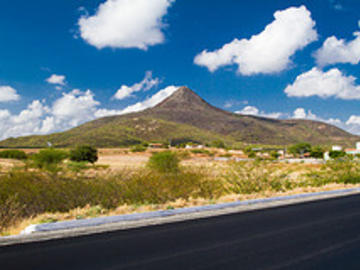Picture
More information on Ecological Park Cabugi

Description: Ecological Park Cabugi
The Cabugi Ecological Park is located between the municipalities and Angicos Fernando Pedroza, specifically in micro-and meso Angicos center of the state of Rio Grande do Norte Rio Grande do Norte, or savanna ecosystem in the region, about seven miles west of Lages, in the central region of the state of Rio Grande do Norte. Peak Cabugi is a geological formation that rises over 500 meters high above the surrounding plains of the region.
The Cabugi Ecological Park was created by State Decree in order to protect one of the few remnants of volcanic activity of the country, save one portion of the Caatinga biome of the surrounding geological formation, order the use and occupation of the area and boost local tourism without depreciating the environment.
The Park presents a significant diversity of natural attractions that can be a factor in attracting visitors motivated by the practice of ecotourism, adventure, educational and contemplative.
The Park is composed of unique vegetation of the Caatinga, riparian forest, disturbed forest, rock and bare soil, culture and temporary ponds. The vegetation of the Caatinga biome covers the whole context of rigorous and semi-arid region presents a face of small scattered trees and thorny shrubs that lose their leaves during the dry period, with the typical flora of the Northeast of Brazil. Regarding his face, one can distinguish two types: savanna-steppe or savanna woodland trees and dense shrub-steppe and savanna woodland or sparse scrub trees and shrubs.
Existing activities
Agricultural practices occur on a small scale emphasizing the cultivation of beans, watermelon, corn and grass during the rainy season, especially along drainages, occupying areas of alluvium. Surrounding the park is registered the occurrence of extensive livestock, with herds of cattle, goats and sheep. Locally there are properties that produce coal and wood from species such as Mimosa hostilis, mesquite, quince and other species typical of savanna.
Attractive environmental.
The Ecological Park Cabugi Peak is one of the highest points of the state, with more than 500 feet high.
It is dated geological formation of 19.7 million years ago, in Miocene times;
Geologically, it is a sub-volcanic neck that records the youngest manifestation of continental magmatism in Brazil;
Their view is perfect, the BR 304;
It is a region of savanna ecosystem;
It has trails of medium and high degree of difficulty
The name of the monument is of Tupi-Guarani origin, which means "river of many stones";
It is a natural icon of Rio Grande do Norte;
It has interesting stories and legends.
Access and transport
The UC has a good location: the access is starting from Christmas or Mossley, major cities of the state, the BR 304 in the central region of the state. It is served regularly by interstate bus lines, which facilitates the increase in demand of visitors.
Accommodation and food
The Lages, Fernando Pedroza Angicos and have lodging facilities that enable you to meet the demand of visitors. The agricultural vocation of the region (cattle, goats and sheep) can become a factor in the visitor's stay, through the positioning of the local cuisine.
Necessary conditions for the practice of ecotourism
Safety of visitors, with the use of personal protective equipment (PPE) and / or collective (EPC), since the place is conducive to the collapse of blocks and loose stones;
It is necessary regulations for access to the top of the Monument, which is encouraged in various tourist sites;
It takes the involvement of local communities.
http://www.idema.rn.gov.br/contentproducao/aplicacao/idema/unidades_de_conservacao/gerados/pico_cabugi.asp
More Photos of Picture

